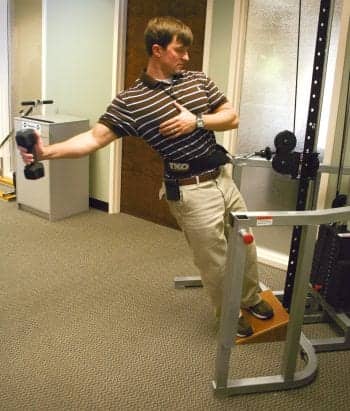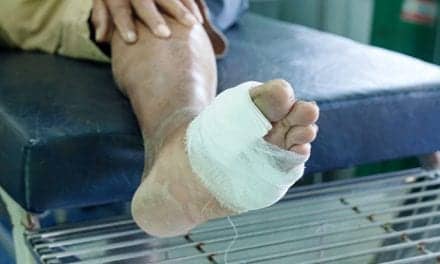
Shoulder exercises are an important part of rehab programs designed for linemen and utility workers. The sooner the patient begins moving in multi-plane patterns, the faster the recovery.
Industrial rehabilitation is an integrated therapy experience for the patient, and it differs from traditional outpatient therapy through a focus on the patient’s work environment, as it provides the therapist an opportunity to “go to work” with the patient. The therapist has the potential to truly make a difference in the patient’s career longevity with a firsthand experience of the work demands. With this opportunity comes great responsibility. Therefore, therapists must utilize efficient and effective treatment approaches. Four key elements for success in industrial rehabilitation include: 1) Utilizing manual therapy with a focus on soft tissue massage/manual muscle release (STM/MMR); 2) Performing functional exercise; 3) Distinguishing noncompliant versus fear-avoidance patients; and 4) Performing return-to-work screens. This article will help therapists implement these four elements of success into practice.
MANUAL THERAPY: STM/MMR
In the early acute care, STM/MMR allows therapists to reduce spasms and correct muscle imbalance. Many of the injuries in the industrial setting involve strains/sprains, especially of the neck, back, or shoulder. STM/MMR helps patients recover quickly and provides patients with a sense of connection with the therapist. Many patients will express confidence in the therapist because of the healing power of touch. A great example is the classic on-the-job low back strain. After injury, most of these patients visit a physician with the anticipation of being placed on light duty and then heading home for the day. These patients typically do not want to move because of the pain they feel, and spend much of their time at rest. Meanwhile, the injured worker’s muscle imbalance worsens and he or she is doing nothing to promote the body’s natural healing. As therapists, one of our most important goals should be to see the patient the day of injury to provide STM/MMR to the shortened muscles such as the psoas/iliacus, hamstrings, or lumbar paraspinals. After releasing the shortened muscles, patients typically experience immediate pain relief and will have increased functional mobility, making them much less likely to develop chronic pain. After pain and spasm are reduced, patients are more willing to participate in pain-free movements with functional exercises.
FUNCTIONAL EXERCISE
Functional exercises with guided movements given early in the rehab plan of care will complement the STM/MMR. They are best defined as multiplane movement patterns that mimic the day-to-day tasks of the job. The sooner the patient begins moving in these multi-plane patterns—such as push/pull, rotation, change of elevation, and locomotion—the faster the recovery. An example of functional exercise to treat low back strain is a modified lunge with rotation and locomotion. The patient can use a therapy ball and rotate the ball in the direction of the stance leg while walking. Walking with exaggerated rotation provides the patient with a natural movement pattern, promoting a bilateral carry and placing activity that is specific to many jobs.
Using verbal cueing, therapists can facilitate transverse abdominis activation, thereby improving core stability and biomechanics with carrying. Guided movements allow patients to have direct tactile feedback, ensuring they fully understand the correct movement patterns and biomechanics. The greatest deterrent to exercise compliance is boredom. Functional exercises provide patients with exercises that mimic their daily routine at work or at home more closely than the traditional one-dimensional exercises. The multidimensional exercises combining all four movement patterns more closely mimic work-related activities.
NONCOMPLIANCE VERSUS FEAR AVOIDANCE

Functional exercises provide the patient with exercises that mimic the daily routine at work or at home more closely than the traditional one-dimensional exercises.
In promoting exercises that are functional to the patient’s job early in the plan of care, we are able to quickly identify two types of patients who may take a little longer to recover or are less likely to recover: patients who demonstrate fear avoidance, and patients who demonstrate noncompliance. Identifying these patients early saves time, money, and therapist frustration. Many therapists find it challenging to differentiate between the two types.
“Fear avoidance” is used to define patients who avoid activities due to the conviction those activities may cause pain or damage. With these patients, therapists may see some catastrophizing of pain, which can lead to poor outcome, depression, high pain levels, and greater impairment and disability. When the fear avoidance is systematically addressed through graded exposure, reassurance, and work simulation, these patients are more likely to return to work.
In contrast, noncompliant patients are defined as patients who are inconsistent with therapy, inconsistent with pain levels and reported symptoms, and inconsistent with level of effort during functional activities and musculoskeletal exams. The key is “inconsistent.” These patients typically demonstrate high pain levels with near-normal movement patterns. Their function varies from visit to visit with differences in self-reported function and observed function. Deviations in movement patterns are also inconsistent. In addition, these patients often make functional tasks more difficult than necessary.
An example of this behavior is observed in the patient who performs an overhead press, and during the lifting of 5 pounds in each hand. This patient may take 30 seconds to complete one repetition and pause at the top of the lift as if he or she were an Olympic power lifter struggling to complete the lift. Most patients who truly are in pain will not take twice as long to complete a lift, nor will they pause at the completion of the repetition. Noncompliant patients are typically less motivated and less likely to return to work due to possible secondary gain. As therapists, our responsibility is to have respectful confrontations with these patients and notify the case managers. We need to objectively quantify the behaviors through return-to-work or fitness-for-duty screens, including the utilization of a consistency-of-effort test once noncompliance becomes an issue in patient care.
RETURN-TO-WORK SCREEN
Determining return to work is one of the most important decisions in industrial rehabilitation. The traditional return-to-work decision involves the patient’s subjective statements to the doctor about pain level and feeling better. This process lacks objective information obtained through functional testing based on the patient’s abilities to perform job demands. Return-to-work screens provide an objective alternative to traditional decision-making and are a great way for clinics to distinguish their services from all competitors.
Therapists are often very focused on treating patients throughout the day and lose track of impending discharges. It is important to at least schedule a return-to-work screen before the final physician appointment. If the screen must be delayed until after the final physician visit, there will at least be a record the therapist had already initiated the process of the return-to-work screen prior to the final physician visit. Without functional testing, therapists are simply stating in the progress note that the patient is back to—or close to—prior functional level with a lack of objective data with which to quantify their statements. As therapists, we should strive to make sure that the patient is not only back to prior level, but that they also have the strength, biomechanics, and endurance to meet the job demands.
If patients return to work without adequate function, recurrence of the same or similar injuries typically result in additional surgery and cost for the company. Reviewing the job description, isolating the three most challenging tasks, and having patients perform a mini-FCE can become part of the therapeutic exercise for the patients during their second-to-last visit before returning to the doctor. This will provide the therapist with true, functionally objective information to help the physician make the appropriate decision for the patient to return to work. Once patients return to work, schedule a follow-up visit 4 weeks afterward to reassess the patient’s status. This allows the therapist the opportunity to save the company money and also address any lingering issues the patient may report. It also enables the therapist to assess the success of treatment. By ensuring that all issues are resolved or addressed, the employer saves money.
SUMMARY
Industrial rehab is a personal invitation into the backbone of employers and their employees. We, as therapists, have the opportunity to implement more effective rehabilitation and reduce the employer’s health care costs. This scenario is truly a win-win-win situation for your clinic, the employer, and the employee. Providing manual therapy with STM/MMR and functional exercise, identifying the fear-avoidance versus noncompliant patients, and implementing return-to-work screens are great ways to ensure successful outcomes as well as client retention, which will increase the likelihood your services will be retained for many years to come.
Ryan Hunt, DPT, CSCS, is outpatient services manager for ErgoScience Inc, Birmingham, Ala. For more information, contact .





